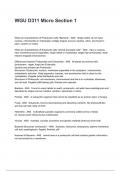WGU D311 Micro Section 1
What are characteristics of Prokaryotic Cells "Bacteria" - ANS Single celled, do not have
nucleus, mitochondria or chloroplast, multiple shapes (coccus, bacillus, vibrio, etc) found in
pairs, clusters or chains
What are characteristics of Eukaryotic cells "animal and plant cells" - ANS Have a nucleus,
have membrane bound organelles, single celled or multicellular, larger than prokaryotes, linear
histone wrapped chromosomes
Differences between Prokaryotes and Eukaryotes - ANS All plants and animal cells
(protozoans , algae, fungi) are Eukaryotic.
bacteria and archaea are Prokaryotic
Structures if Eukaryotic: nucleus, membrane organelles in the cytoplasm ( mitochondria,
endoplasmic reticulum, Golgi apparatus, lysomes, and peroxisomes held in place by the
cytoskeleton. Flagella (whip like/flexible) and cilla
Structures of Prokaryotic: cell membrane, chromosomal dna that is in nucleotide, ribosomes,
and cell wall. Flagella (stiff/rotating) pilli, fimbriae and capsules
Bacteria - ANS Found in every habitat on earth, prokaryotic, cell walls have peptidoglycan and
described by shape (coccus, bacillus, spirillum, spirochete or vibrio)
Protists - ANS A eukaryotic organism that cannot be classified as an animal, plant, or fungus.
Fungi - ANS Eukaryotic, lives by decomposing and absorbing nutrients. Not photosynthetic
and has cell wall made of chitin
Helminths - ANS multicellular parasitic organisms commonly called worms or flukes
ex: Guinea worm (Dracunculus medinensis)
Viruses - ANS Acellular, consists of proteins and genetic material (dna/rna) never both
Bacterial Structures "prokaryotic" - ANS Nucleoid, ribosomes, endospores, plasma membrane,
cell wall, peptidoglycan, flagella, fimbriae, pilli
Nucleoid of Bacteria - ANS central area in a prokaryotic cell that contains genetic information,
not surrounded by a membrane
, Ribosomes of Bacteria - ANS site of protein synthesis. 70S composed of two subunits (30S
small and 50S large and are composed of protein and rRNA components
Endospores of bacteria - ANS form around DNA when stressed, protect until conditions are
good
Plasma membrane in bacteria - ANS phospholipid bilayer with embedded proteins that defines
the boundary of the cell
Cell wall of bacteria - ANS made of peptidoglycan and help maintain shape and withstand
changes in osmotic pressure
Peptidoglycan of bacteria - ANS is part of the cell wall.
is made of sugars and proteins.
Flagella of bacteria - ANS acts as a propeller to move the cell. Stiff, rotating structure.
Fimbriae of bacteria - ANS hairlike bristles that allow adhesion to surfaces
Pili of bacteria - ANS Appendages that allow bacteria to attach to each other and to transfer
DNA
Chemotaxis - ANS Directional movt from a call in response to chemical attraction
Phototaxis - ANS movement in response to light using flagella
Bacterium "runs" - ANS Movt of bacteria counterclockwise flagellar rotation
Bacteria "tumbles" - ANS Random movt of bacterial cell by clockwise flagellar rotation
vegetative cell - ANS metabolically active and growing and does not contain endospores.
Sensitive to extreme temps and radiation, gram positive, normal water content
Endospores - ANS A thick-walled protective spore that forms inside a bacterial cell and resists
harsh conditions (extreme temps and radiation) does not absorb gram stain. No growth
Why is sporulation important for bacteria - ANS Protects bacteria agaisnt degrading agents,
unfavorable growth and nutrient depletion
What are 6 steps of sporulation process - ANS DNA replicates, membranes form around dna,
forespore forms additional membranes, protective cortex forms around the spore, protein coat
forms around the cortex and spore is released




